It’s the end of October as I write this, midday, and I just spotted a deer while driving home from a quick trip to town. Smack in the middle of a wide-open cut cornfield, with the sun high in the sky, was a 150-class tank of a buck trotting through the stubble, nose to the ground, following the scent, I assume, of an early-estrus doe. It’s not even November yet, but the rut is here. And all of a sudden, I can’t wait to get into a tree stand.
The very beginning of the rut is the best. Not because deer activity is at its peak, but because the anticipation of it is. The best deer hunting of the year is right in front of us. And to be sure you make the most of it, we have reached to the country’s top deer experts and guides and collected their best 50 tips for hunting every phase of the whitetail rut. If you’ve got your phone handy, you can read them once you climb into your own tree stand. Just don’t forget to look up every few seconds.
Phase One: Late Pre-Rut

Although most does aren’t yet ready to breed, bucks are feeling increasingly amorous, moving more within their home range, rubbing and scraping. It’s a great time to kill a giant, before he finds that first willing doe and abandons any patterns in his core area. Here are out experts top tips for this phase of the breeding season.
1. Hunt the Bullies
“It’s time to go after the most aggressive deer. Identify them either by direct observation or via trail camera. Bully bucks will posture at other bucks, won’t give up prime feeding spots to them, and often move during daylight. I’ll set up on the edge of thick cover that I know an aggressive buck is using. Then I work a grunt call that sounds like a young buck tending a doe. I’ve killed several dandies that came charging to this call.” —Grant Woods, whitetail biologist, GrowingDeer.TV
2. Get the Big Picture
As bucks seek does, their entry points into fields become less predictable. To keep closer tabs, back your cameras off specific trails, and instead watch the whole field or plot in time-lapse mode.—S.B.
3. Go Mobile
“The late pre-rut is when a mostly nocturnal buck will start moving in daylight, but you have only a handful of days to kill him in his core area. So I place cellular trail cams on active scrapes, and when I start getting daytime pics, I move in immediately and hunt.” —Steve Stoltz, pro staffer, Mossy Oak

4. Reap the Harvest
“Our corn harvest often coincides with this period, and when the combines come out, bucks that have been living in cornfields are forced to use other cover. We hunt woodlots, creekbottoms, and other thick cover close to the corn. And we sit all day. This works well during the pheasant opener too.”—_Tim Clark, Kansas outfitter, Reddog Outfitters
5. Sneak a Scrape
“Scout to find primary scrapes near buck bedding areas. Then pick a stand tree and get out. Don’t hang a stand or leave a camera. Come back on a day when the wind is perfect. When you return, you’re there to kill him, not hunt him. Sneak in, and quietly hang your stand, because the buck is likely bedded within earshot. I’ve seen 19 different bucks in a five-day period using this tactic. I’ve also killed one in 20 minutes. It can go that fast.” —Harry Pozniak, Kentucky outfitter, River Valley Farms

6. Take Some Licks
Field and food-plot edges are often lined with licking branches now, all vying for a buck’s attention. Force a shooter to work the one closest to your stand by first walking the field edge and cutting off every competing licking branch.—S.B.
7. Plant a Tree
“Small food plots are awesome right now, as bucks check them for does. To pull those deer into bow range, cut a small cedar tree, use a posthole digger to dig a hole within 20 yards of your stand, and then drop the tree in and make a mock scrape underneath it. Every buck coming to that plot will go straight to your scraping tree, and you’ll have a shot.” —Kevin Harris, Missouri outfitter, Honey Creek Outfitters

8. Get Loud
Expect aggressive behavior during the last few days of the pre-rut, with bucks trolling hard for that first hot doe. Rattling, calling, and decoys should all be in play today. Put yourself in a high spot, where sound will carry, preferably where your scent will pass over any buck the circles downwind, and then hammer the horns. And stay on your toes. —S.B.
Related: Best Cellular Trail Cameras of 2025
Phase Two: Seeking

Ever watched a great bird dog working cover to find a hunkered-down pheasant or quail? That’s your whitetail buck right now, only he’s looking for does. With testosterone levels surging, bucks start patrolling like crazy, checking food sources, doe bedding sites, and transition areas for that first bit of action.
9. Read a Buck’s Body Language
“The key to calling in bucks is reading body language. When bucks are seeking, I look for an animal that’s traveling with intent and seemingly unaware of his surroundings. Any slow-moving buck is no good; I leave him alone. But if he’s moving right along, I know he’s looking for something to chase or harass. Bonus points for any buck with his ears laid back and hair erect. He’s telling me he’s feeling aggressive, and he’ll come to the first call he hears.” —Mark Drury, TV host, Drury Outdoors
10. Get a Good View
“For much of the year, bucks stick to thick cover, but that changes now. They really start using their eyes to find other deer, and they seek out open areas to do so. I copy them by choosing stands in areas where I can see well, especially on an afternoon hunt.” —Dan Perez, land manager and TV host, Whitetail Properties
_

11. Go It a Lone
“Any time I hunt open or broken cover, I look for a large lone tree or brushpile. Bucks crossing between patches of cover will go to that lone tree like a magnet, pausing to assess their surroundings before moving on. These spots are especially deadly when bucks are covering lots of ground to find does.” —Mark Clifford, Kentucky outfitter, Premier Outfitters
12. Spy on the Girls
“Lots of guys delete doe pictures from their trail cameras, but right now the does tell you where the bucks will be. I keep close tabs on my cameras and scan cards for the spots with the best doe activity—and then I immediately put my hunters in those spots.”—T.C.
13. Talk Like a Lady
“Up until this phase in the rut, I stick mainly to grunting and rattling for pulling a buck into range. But now’s the time to switch to doe bleats. By this point a buck might be tired of fighting or just had his butt kicked. But he is most definitely in the mood for a doe.” —Joe Gizdic, land manager and Illinois guide, Whitetail Properties

14. Kill a Frost Giant
“I love to hunt the first hard frost of the year, which often occurs during the seeking phase. The early-morning cold puts deer off food sources before daylight, and they go back in the timber to bed. When the sun warms things up—usually eight or nine o’clock—they move back out to feed for a while. So I get in a stand before first light and catch bucks moving out to feed at midmorning, then back to bed again in late morning. Bucks are both feeding and harassing does the whole time. The action can be incredible.”—M.D.
15. Throw a Bomb
“Every time I walk to a stand I grab some hedge apples. When I get in my spot, I put doe-in-heat scent gel around an apple, and then toss it so it rolls across the game trail and into a shooting lane. When a buck comes through, he’ll stop and sniff that scent trail—which leads away from my stand—giving me a broadside shot at a standing deer that’s looking the other way.” —Barry Wensel, bowhunting legend, Brothers of the Bow

16. If You’re a Bowhunter, Go Now.
A lot of hunters plan their days off or their travel to a top whitetail state around the chasing phase of the rut. It kind of makes sense because that’s when you will see that most action. But if you’re a bowhunter, the seeking phase is a better time to tag a monster. Archers need bucks to not only walk into bow range, but stop or move slowly enough to present a good shot. Once bucks start chasing in earnest, that becomes less likely. Plus, bucks are harder to lure into bow range with calls when they are busy dogging real does. If you’re using archery tackle, now is your prime time. —Dave Hurteau
Related: Best Compound Bows of 2025, Tested and Reviewed
Phase Three: Chasing
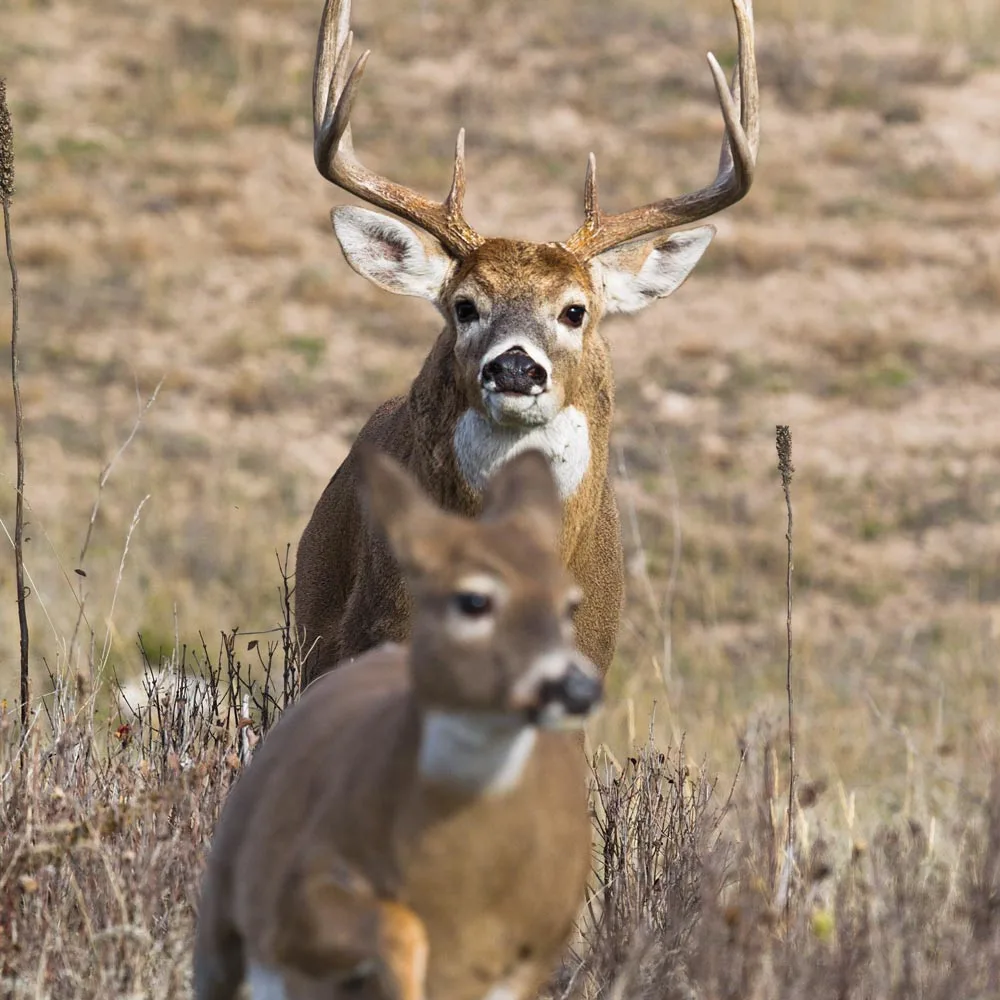
The lid has popped off the pressure cooker. The first few does are being bred, the scent of estrus is in the air, and every buck in the herd is a heat-seeking missile. When most hunters describe “peak rut,” this is the phase they mean. Biologically speaking, the apex of breeding activity is yet to come. But for hunters, this is the big show.
17. Pick a Fight
“The best buck call now is one you can make with your mouth. A snort-wheeze is the equivalent of walking into a biker bar and poking the biggest guy right in the chest. When I see a lone, mature buck cruising during the rut, I don’t bother with grunts, bleats, or antlers. I go straight to a snort-wheeze. Eighty or 90 percent of the time, that buck is coming.”—B.W.
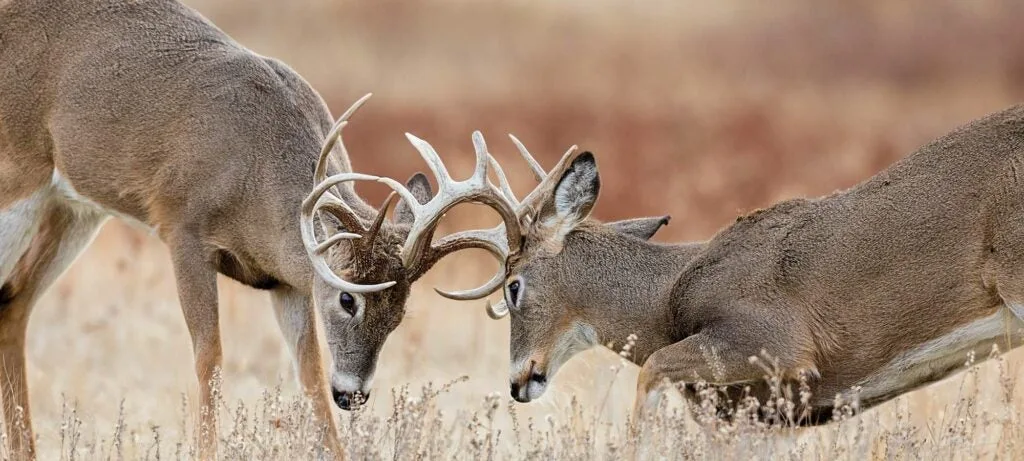
18. Go Nuts
Does that aren't ready to breed don't want to be bothered by bucks, and they know that their suiters are less likely to spot them if they stay in the timber, not far from thick cover. This makes oak flats prime doe feeding areas now. Do some quick midday scouting to find the best feeding sign under the oaks then hand a stand and settle in. And don't forget your bleat call. —D.H.

19. Set a Double Deke
During the chasing phase, a buck-and-doe decoy combo is a kind of double-whammy on lovesick bucks. The fake doe plays on their need to breed, while the fake buck plays the jealously card. Set up on the edge of a field where there's plenty of visibility, and be ready to call to any buck you see to get his attention. —D.H.
20. Make an Interception
“I’m convinced that chasing-phase bucks try to intercept does as they move back to bedding areas in the morning. So I look for a funnel off a good food source that connects multiple doe bedding areas, and I get there well before daylight. Bucks will show up early, waiting for those does to come off the feed.”—D.P.
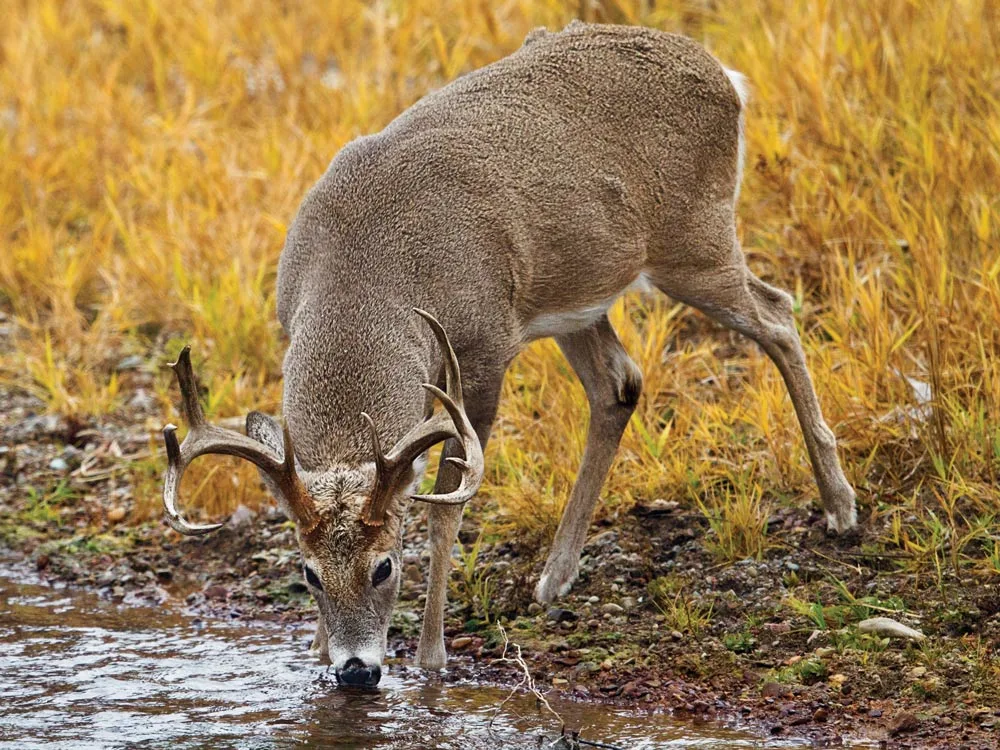
21. Hit the Water
If ever you’re not sure where to set up during the chasing phase, head for water, scout for the best sign nearby, and hang a stand. Hard-running bucks need to drink, so any pond in the timber can be on fire now. Creeks and rivers can be even better, as they offer both a water source and a prime travel corridor.—S.B.
22. Get a Head
“My success at decoying bucks into bow range went up dramatically when I took the plastic head off my decoy and mounted a piece of plywood in the opening, with a hook attached. Now I can take any one of my taxidermy mounts, hang it on that hook, and I have the most realistic decoy any buck has ever seen. I’ve watched some big whitetails come from a long way to check that thing out.”—M.D.

23. Find a Macro-Funnel
During the chasing phase, bucks start making doe-seeking forays outside of their core areas. Suddenly, they are covering much more ground, and means it’s time for you to look at the picture. Pull up a mapping app on satellite view and look for natural funnels that connect your properties to others. Ask yourself, if a buck were travel a mile or more away to find does, from your property to another or vice versa, what pinch points and bottlenecks and corridors would he use. Then set up there and wait. —S.B.
24. Don’t Ignore Buck Core Areas
A lot of hunters think bucks abandon their core areas during the peak of the rut, but that isn’t the case. They do leave those areas on potentially long doe-seeeking forays, but they come right back to those pre-rut safe places on a regular basic to rest up before their next jaunt. If you have a spot on your property where you know a big buck has everything he needs and feels safe, don’t necessarily quit on it now. You may have to be patient, but he’s coming back. —S.B.
Related: Best Deer Rifles of 2025
Phase Four: Peak Breeding

This is when the majority of does enter estrus. Most biologists consider this the rut’s peak. Most hunters call it lockdown—and want to pull their hair out. Bucks that teemed in the timber just days ago seem to vanish as they tend does. But they’re not gone.
25. Bust Them Like Bunnies
“During lockdown, bucks corral does in small oddball covers. My rule is: If it’s big enough to kick a rabbit from, it’s big enough for a buck to rat-hole a doe. I’ll sneak close to that isolated cover and rattle or call to suck in a buck that’s tending a doe. We’ve killed eight or 10 bucks scoring 170 or better with this technique.”—J.G.
26. Catch Some Sun
“Does—even receptive ones—seek thick cover now to avoid being harassed by bucks. South-facing slopes are perfect, since they feature brushy habitat that’s also warmed by the sun. That combination makes these areas great ambush sites for receptive does and the mature bucks that follow them.”—G.W.
27. Move a Little Closer
“Breeding pairs are famous for locking down for hours at a time. But sooner or later one of the two deer will want to get up and stretch its legs, and the other one will follow suit. Since they’re not going far for a couple of days, I use that chance to move a stand closer and wait for them to return. It might take a couple of setups, but eventually I’ll be close enough to get a good shot.”—D.P.

28. Quiet Your Steps
“Doe bedding areas are good places to find a buck that has a mate pinned down. To get to stands in these areas, I make places to put my feet along the last 75 yards of my entry path by scraping 12-inch spots down to bare dirt. Then I can slip in without a sound. I’ve sometimes had a big buck stand up after hours of being bedded close to my stand with his doe.”—B.W.

29. Stay Put
If you can only handle a few of all-day sits in a season, save at least a couple for lockdown, and set up near a thick doe bedding area. Once a buck is done tending one doe, he’s going to look for the next, no matter what time of day it is. Plus, lockdown aligns with the rifle season in a lot of states, which can get a buck on his feet at midday. —S.B.
30. Do a Double Drag
“I take a hunter out in a Bad Boy Buggy or ATV, and when we get close to the stand, I run a double drag rag, one on each side of the machine. One rag is doused with doe-in-heat urine, the other with buck urine. That scent trail is a perfect imitation of a buck following an estrous doe—and it drags in shooters now.” —Larry Porter, Kentucky and Tennessee outfitter, Ken Tenn Hunting

31. Glass and Stalk a Breeding Pair
Every year during lockdown, I’ll spot big bucks tending does out in the open, often near some little patch of cover. If you have access to a lot of ground and you don’t have the patience needed to wait out peak-rut bucks, bust out the big glass (15x truck binos or a window-mounted spotting scope) and try whitetail hunting, spot-and-stalk style. And have your phone handy: You’d be surprised how many farmers will let you make a one-time stalk on a buck if you show them a picture of him. —S.B.
Phase Five: Pickup Breeding
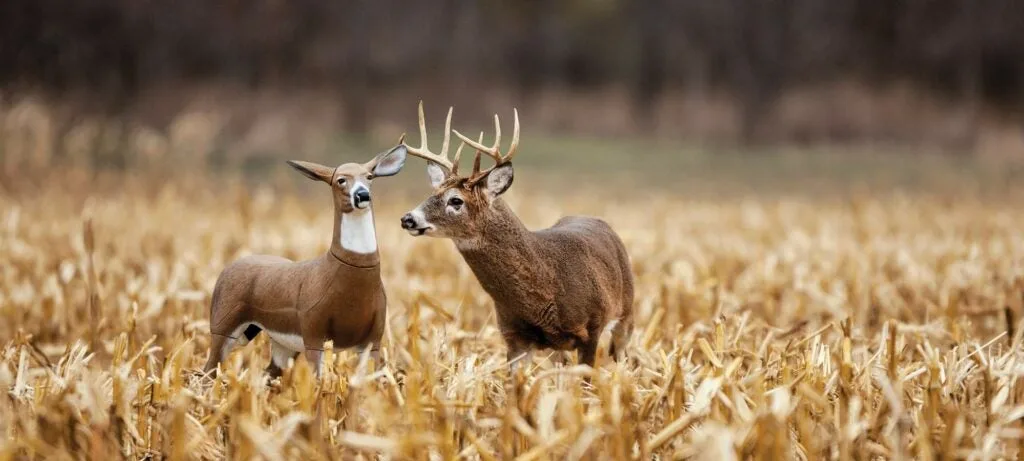
No, this is not a whitetail attempting to mount a truck. It is, however, one of the best times to smash a mature buck. While peak breeding is past, there are a handful of does still to be bred, and after weeks of running, fighting, chasing, and breeding, it’s the older, bigger bucks in particular that have the stamina to keep looking for those last breeding opportunities
32. Work the Wind
“I like to set up along a travel corridor so that the wind is almost perfect for the buck and almost wrong for me. Sometimes that exists where there’s some obstacle that forces a buck to travel without the wind in his face for a short distance. Other times a buck may travel with the wind quartering into his face, rather than full into his face. He thinks he’s O.K., but there’s just enough angle for you to take advantage.”—B.W.
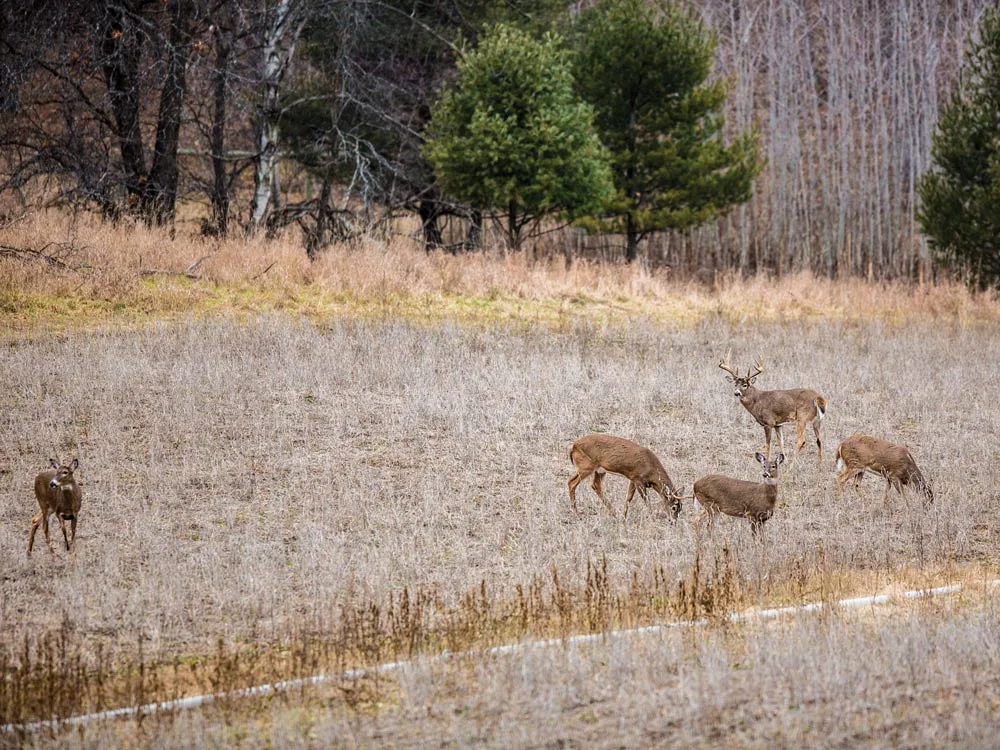
33. Make a Midday Run
“When older bucks are seeking out those last does, the action takes place near the best doe feeding areas. I leave these spots alone in the morning and check cameras there at midday to see where the most does are feeding. Then I hunt the hottest spots in the afternoon. I always see bucks that I’ve never seen before—I think they’re mature bucks from other areas—and it’s an excellent time to shoot a giant.” —Chris Parrish, pro staffer, Knight & Hale
34. Go With a Doe
“At this point in the season, lots of bucks are tired of fighting. So I switch to a lone-doe decoy setup. I focus on ag fields and food plots in the afternoon and use lots of estrous scent and a can call.” —Tim Herald, hunting consultant and TV host, Worldwide Trophy Adventures

35. Back Off
“We kill mature bucks during this phase every year with a simple tactic: setting up 100 to 200 yards off a prime food source that does are hitting hard. Does bomb into the field to feed, but bucks linger in that safe zone, waiting for the does to come back to them. While they wait, they make plenty of rubs and scrapes. Set up on that sign, and you’ll have encounters with bucks in good shooting light, as opposed to hunting right on the food.”—T.C.

36. Rattle Late
“I like to head to field edges or other spots where I can see a good ways, and I keep my rattling antlers close. I feel that if I see a good buck, I can call him in. He’ll be frantic to find a doe, so the rattling will get his attention, and if he doesn’t charge in to that, I go straight to grunts and bleats. But rattling now kills some of the best bucks in the country.”—J.G.
37. Go Full Out
“I call this the ‘desperately seeking’ phase, and in my opinion it is the single best time of the year to kill a buck that is 5 1⁄2 years old or older. They’ve been so lazy all year long, they’re the only ones with energy left for does. My favorite time to hunt is midday during a full moon. A big, seeking buck is already apt to move at midday, and movement is always better when you’ve got a full moon.”—M.D.
38. Take a Tarsal
Many hunters know the trick of cutting the tarsal or “hock” gland off a buck or doe and using it as a scent attractant. What you may not know is that the pickup breeding phase is an especially good time to put this trick to work. At this point in the rut, after weeks of rub urination (done by both bucks and does), tarsals positively reek. Plus, increasingly wary bucks are more likely to fall for the most realistic scent you can get your hands on.—S.B.
39. Decorate Your Stand
“By late fall, leaves are gone and it’s easy to get silhouetted in a stand. Every year I go to the landfill and grab fake Christmas trees people have tossed. They’re usually in a couple of sections, so I take those sections and wire one on each side of my stand tree. It forms a block of cover to hide you, and the deer get used to it in a hurry. If you can’t find old Christmas trees, pin oak, cedar, or juniper works, too.” —B.W.

40. Track a Trophy
Big-woods trackers call this the recovery phase of the rut. Peak breeding is over, and while bucks will still breed opportunistically, they are for the most part looking to feed and rest up for the impending winter. This is also when the North Woods tends to get it first good tracking snow. When you find a buck track during the peak rut, it’s almost impossible to catch up to that big-traveling deer to get a shot. But now, you can. So go get on some deep-set hoofprints in the big woods and walk down a trophy. —S.B.
Related: Best Crossbows of 2025, Tested and Reviewed
Phase Six: Secondary Breeding

Every year, some does come into estrus roughly a month after the annual peak. Some of these are mature does that got missed during the main event; others are fawns entering their first cycle. It’s only a handful of receptive females compared with November—but it’s the biggest bucks that are looking for them.
41. Find the Fawns
“In areas where there’s been a heavy doe harvest, late-cycling fawns will form a group that visits a food source almost daily. Find them and your odds of killing a mature buck will soar.”—G.W.
42. Bring the Horns
“I once watched 18 bucks chasing one estrous doe during this phase. When there was a break in the action, I hit my rattling antlers and was able to pull several of those bucks within bow range.”—D.P.
43. Go for the Green
“Available green food trumps beans and corn now. Mossy Oak’s Winter Bulbs & Sugar Beets is my favorite, but clover, rye, or wheat will also pull in giant bucks, as well as the does they’re after.”—M.D.
44. Hush It
Bring a piece of scrap carpet and then roll it out on your stand platform or blind floor. This soft, flexible pad will help silence your setup and keep your feet warm.—S.B.
45. Watch Your Step
“Food sources are everything now, but with leaves down and bucks bedding tight to the food, your approach is critical. Start by hunting the safest, outside edges, and don’t move in unless you’re sure you can set up without getting busted. Be willing to walk a lot farther than usual.”—J.G.
46. Embrace the Blur
“Lots of guys get irritated by the blurry or half-a-deer images they get on trail cams. Right now, I see a blurry deer as either a doe on the run, or the buck that’s chasing her. When I check my cams and see those blurry pics, there’s a hunter in that spot the next day.”—T.C.
47. Scrape Redux
“The secondary breeding period is one of the best times to go right back to hunting a primary scrape, because that’s where any secondary rut action is going to happen.”—H.P.
48. Shine a Light
To get out of a food-source evening stand without spooking late-season deer, wait for full dark, and then shine a powerful flashlight into the eyes of nearby feeding deer. The bright light won’t spook deer but will confuse and blind them to your escape.—S.B.
49. Tramp a Trail
“When deep or ice-crusted snow makes travel difficult for bucks, head to a hot food source and use heavy boots to pound a trail from the grub into the woods. Deer are so hungry now they’ll quickly forget your intrusion and start using your trail for easier walking. Make a trail to your stand, too, so you can set up silently.” —Garry Greenwalt, Washington outfitter, wildcountrygs.com

50. Hunt the Right Grub
A handful of bucks are still breeding, but this is still the late season—and that means that the most important thing in every whitetail’s world right now is food. Even for the buck that dead-set on breeding the latest-cycling does, he knows full well that he’ll find them at the hottest food sources. So, that’s where you should be. But you might have several good late-season food sources on your property. How do you pick the right one? Well, here’s a tip I got from a whitetail guide years ago. When it’s unseasonably warm, hunt green food sources, like brassicas or alfalfa sticking up above the snow. If it’s cold, go for the grains, corn and beans. That advice has worked great for me, and I’m betting it will for you too. —S.B.



